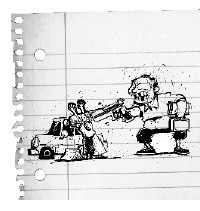Pepe and Wilcox
Earlier this year, you printed an interview with Joe Pepe, the newly appointed publisher of The Commercial Appeal. That interview may have left the impression that in the past, The Commercial Appeal‘s strategies and practices were the result of decisions made exclusively by local management and, in particular, by former publisher John Wilcox.
To avoid any confusion left in your readers’ minds, I’d like to make it clear that we at The E. W. Scripps Company, owner of The Commercial Appeal, carried ultimate accountability for strategies pursued in Memphis.
Most important, I’d like to let your readers know that Wilcox kept The Commercial Appeal‘s best interests in the forefront and worked diligently to make the newspaper stronger. He had a long and successful career with Scripps in Florida, California, and West Tennessee. We apologize for any misimpressions the interview may have caused.
John is now off on another adventure, working to prove out a new media model for the San Francisco Bay area. We’re watching his progress, rooting for his success, and wish him well in all future endeavors.
Richard A. Boehne
Chief Operating Officer
E.W. Scripps Company
Editor’s note: The article Man With a Plan by Chris Davis referenced by Boehne appeared in the Flyer‘s April 7th issue. Wilcox was Pepe’s predecessor at the CA.
Twisted Logic
Last week (October 19th issue) the Flyer published a letter from a Corker supporter from Chattanooga (EN: here). In this woman’s twisted logic, a Corker loss in the Senate race could make Nancy Pelosi the Speaker of the House of Representatives. The Senate and the House of Representatives are two separate institutions. If someone is elected to one, it has no effect on who takes a leadership position in the other.
Apparently, they forgot to cover that in Talking Point School. Is there hope for America? Yes there is, but it won’t come from mindlessly regurgitating Republican talking-points or electing Bob Corker to anything.
John Manasco
Memphis
The Links at Taj Mahal
The article about the “Taj Mahal” clubhouse at Riverside Golf Course (October 19th issue) brought back into stark relief the inequities and mismanagement of the city’s golf-course system.
While the city has spent unnecessary millions upgrading and gentrifying courses in the politically connected parts of town, one of the system’s diamonds in the rough has been woefully ignored. I’m referring to the Links at Pine Hill. Located in South Memphis (apparently where politicians don’t have any clout), I have watched that course deteriorate at the hands of an administration that treats it like an illegitimate stepchild.
After years of intense lobbying by patrons, the city finally replaced Pine Hill’s decrepit golf carts, but it has yet to protect those carts with a secure storage facility. And while other courses in the system are teeming with maintenance equipment and workers, Pine Hill is on the verge of going to seed. The parking lot looks like an Iraqi battlefield, and while other courses in the system have had their clubhouses upgraded, Pine Hill’s remains, euphemistically speaking, rustic.
Pine Hill doesn’t need to be Taj Mahhalled to be brought back to its former glory. But it needs administrators who care about it (and its patrons) and are willing to allocate it its fair share of city funds and attention.
Martin H. Aussenberg
Memphis
Bush and Putin
President Bush and his friend Russian president Vladimir Putin seem to be on the same page. Bush signs a bill that suspends habeas corpus, a basic right of Americans since the founding of our nation. At the same time, Putin is using a new law to ban nongovernmental organizations such as Amnesty International and Human Rights Watch.
Both presidents have legislative bodies that are full of “yes men” who provide little or no oversight. Both presidents have attacked the press using government agencies or planting false stories. This administration even went so far as to allow a fake reporter (Jeff Gannon) to become part of the White House press corps.
Its time to stop the erosion of our freedoms by a Republican controlled government full of unethical elected (and unelected) officials.
Jack Bishop
Cordova


 Justin Fox Burks
Justin Fox Burks  Greg Cravens
Greg Cravens